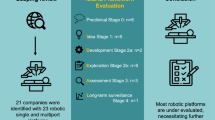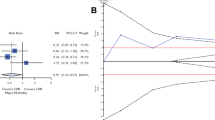Abstract
The objective of the study is to compare the safety and efficacy of robot-assisted pancreaticoduodenectomy (PD) with open PD. The PubMed, EMBASE and Cochrane Library databases were searched for the literature available from their respective inception dates up to May 2020 to find studies comparing robot-assisted pancreaticoduodenectomy (RPD) with open pancreaticoduodenectomy (OPD). The RevMan 5.3 statistical software was used for analysis to evaluate surgical outcome and oncology safety. The combination ratio (RR) and weighted mean difference (WMD) and their 95% confidence intervals (CIs) were calculated using fixed-effect or random effect models. 18 cohort studies from 16 medical centers were eligible with a total of 5795 patients including 1420 RPD group patients and 4375 OPD group patients. The RPD group fared better than the OPD group in terms of estimated blood loss (EBL) (WMD = − 175.65, 95% CI (− 251.85, − 99.44), P < 0.00001), wound infection rate (RR = 0.60, 95% CI (0.44, 0.81), P = 0.001), reoperation rate (RR = 0.61, 95% CI (0.41, 0.91), P = 0.02), hospital day (WMD = − 2.95, 95% CI (− 5.33, − 0.56), P = 0.02), intraoperative blood transfusion (RR = 0.56, 95% CI (0.42, 0.76), P = 0.0001), overall complications (RR = 0.78, 95% CI (0.64, 0.95), P = 0.01), and clinical postoperative pancreatic fistula (POPF) (RR = 0.54, 95% CI (0.41, 0.70), P < 0.0001). In terms of lymph node clearance (WMD = 0.48, 95% CI (− 2.05, 3.02), P = 0.71), R0 rate (RR = 1.05, 95% CI (1.00, 1.11), P = 0.05), postoperative pancreatic fistula (RR = 1, 95% CI (0.85, 1.19), P = 0.97), bile leakage (RR = 0.99, 95% CI (0.54, 1.83), P = 0.98), delayed gastric emptying (DGE) (RR = 0.79, 95% CI (0.60, 1.03), P = 0.08), 90-day mortality (RR = 0.82, 95% CI (0.62, 1.10), P = 0.19), and severe complications (RR = 0.98, 95% CI (0.71, 1.36), P = 0.91), and there were no significant differences between the two groups. Robotic surgery was inferior to open surgery in terms of operational time (WMD = 80.85, 95% CI (16.09, 145.61), P = 0.01). RPD is not inferior to OPD, and it is even more advantageous for EBL, wound infection rate, reoperation rate, hospital stay, intraoperative transfusion, overall complications and clinical POPF. However, these findings need to be further verified by high-quality randomized controlled trials.




Similar content being viewed by others
References
Giulianotti PC, Coratti A, Angelini M et al (2003) Robotics in general surgery: personal experience in a large community hospital. Arch Surg 138(7):777–784
Baimas-George M, Watson M, Murphy KJ et al (2020) Robotic pancreaticoduodenectomy may offer improved oncologic outcomes over open surgery: a propensity-matched single-institution study. Surg Endosc. https://doi.org/10.1007/s00464-020-07564-x (published online ahead of print, 2020 Apr 23)
Baker EH, Ross SW, Seshadri R et al (2016) Robotic pancreaticoduodenectomy: comparison of cs and cost to the open approach. Int J Med Robot 12(3):554–560
Bao PQ, Mazirka PO, Watkins KT (2014) Retrospective comparison of robot-assisted minimally invasive versus open pancreaticoduodenectomy for periampullary neoplasms. J Gastrointest Surg 18(4):682–689
Boggi U, Napoli N, Costa F et al (2016) Robotic-assisted pancreatic resections. World J Surg 40(10):2497–2506
Buchs NC, Addeo P, Bianco FM, Ayloo S, Benedetti E, Giulianotti PC (2011) Robotic versus open pancreaticoduodenectomy: a comparative study at a single institution. World J Surg 35(12):2739–2746
Cai J, Ramanathan R, Zenati MS et al (2020) Robotic pancreaticoduodenectomy is associated with decreased clinically relevant pancreatic fistulas: a propensity-matched analysis. J Gastrointest Surg 24(5):1111–1118
Chalikonda S, Aguilar-Saavedra JR, Walsh RM (2012) Laparoscopic robotic-assisted pancreaticoduodenectomy: a case-matched comparison with open resection. Surg Endosc 26(9):2397–2402
Chen S, Chen JZ, Zhan Q et al (2015) Robot-assisted laparoscopic versus open pancreaticoduodenectomy: a prospective, matched, mid-term follow-up study. Surg Endosc 29(12):3698–3711
Gall TM, Pencavel TD, Cunningham D, Nicol D, Jiao LR (2020) Transition from open and laparoscopic to robotic pancreaticoduodenectomy in a UK tertiary referral hepatobiliary and pancreatic centre— Early experience of robotic pancreaticoduodenectomy. HPB (Oxford) (published online ahead of print, 2020 Apr 1)
Girgis MD, Zenati MS, King JC et al (2019) Oncologic outcomes after robotic pancreatic resections are not inferior to open surgery. Ann Surg. https://doi.org/10.1097/SLA.0000000000003615 (published online ahead of print, 2019 Oct 28)
Ielpo B, Caruso R, Duran H et al (2019) Robotic versus standard open pancreatectomy: a propensity score-matched analysis comparison. Updates Surg 71(1):137–144
Jin JB, Qin K, Yang Y et al (2020) Robotic pancreatectomy for solid pseudopapillary tumors in the pancreatic head: a propensity score-matched comparison and analysis from a single center. Asian J Surg 43(1):354–361
Kauffmann EF, Napoli N, Menonna F et al (2019) A propensity score-matched analysis of robotic versus open pancreatoduodenectomy for pancreatic cancer based on margin status. Surg Endosc 33(1):234–242
Kim HS, Han Y, Kang JS et al (2018) Comparison of surgical outcomes between open and robot-assisted minimally invasive pancreaticoduodenectomy. J Hepatobiliary Pancreat Sci. 25(2):142–149 (published correction appears in J Hepatobiliary Pancreat Sci. 2018 Apr;25(4):254)
Kowalsky SJ, Zenati MS, Steve J et al (2019) A combination of robotic approach and ERAS pathway optimizes outcomes and cost for pancreatoduodenectomy. Ann Surg 269(6):1138–1145
Lai EC, Yang GP, Tang CN (2012) Robot-assisted laparoscopic pancreaticoduodenectomy versus open pancreaticoduodenectomy—a comparative study. Int J Surg 10(9):475–479
Marino MV, Podda M, Gomez Ruiz M, Fernandez CC, Guarrasi D, Gomez FM (2020) Robotic-assisted versus open pancreaticoduodenectomy: the results of a case-matched comparison. J Robot Surg 14(3):493–502
McMillan MT, Zureikat AH, Hogg ME et al (2017) A propensity score-matched analysis of robotic vs open pancreatoduodenectomy on incidence of pancreatic fistula. JAMA Surg 152(4):327–335
Mejia A, Shah J, Vivian E, Acharya P (2020) Analysis of 102 fully robotic pancreaticoduodenectomies: clinical and financial outcomes. Pancreas 49(5):668–674
Napoli N, Kauffmann EF, Menonna F et al (2018) Robotic versus open pancreatoduodenectomy: a propensity score-matched analysis based on factors predictive of postoperative pancreatic fistula. Surg Endosc 32(3):1234–1247
Shi Y, Jin J, Qiu W et al (2020) Short-term outcomes after robot-assisted vs open pancreaticoduodenectomy after the learning curve. JAMA Surg. 155(5):1–6 (published online ahead of print, 2020 Mar 4)
Tan JKH, Ng JJ, Yeo M et al (2019) Propensity score-matched analysis of early outcomes after laparoscopic-assisted versus open pancreaticoduodenectomy. ANZ J Surg 89(5):E190–E194
Varley PR, Zenati MS, Klobuka A et al (2019) Does robotic pancreaticoduodenectomy improve outcomes in patients with high risk morphometric features compared to the open approach. HPB (Oxford) 21(6):695–701
Zhou NX, Chen JZ, Liu Q et al (2011) Outcomes of pancreatoduodenectomy with robotic surgery versus open surgery. Int J Med Robot 7(2):131–137
Zureikat AH, Postlewait LM, Liu Y et al (2016) A multi-institutional comparison of perioperative outcomes of robotic and open pancreaticoduodenectomy. Ann Surg 264(4):640–649
Whipple AO, Parsons WB, Mullins CR (1935) Treatment of carcinoma of the ampulla of vater. Ann Surg 102(4):763–779
Peng L, Lin S, Li Y, Xiao W (2017) Systematic review and meta-analysis of robotic versus open pancreaticoduodenectomy. Surg Endosc 31(8):3085–3097
Podda M, Gerardi C, Di Saverio S et al (2020) Robotic-assisted versus open pancreaticoduodenectomy for patients with benign and malignant periampullary disease: a systematic review and meta-analysis of short-term outcomes. Surg Endosc 34(6):2390–2409
Yan Q, Xu LB, Ren ZF, Liu C (2020) Robotic versus open pancreaticoduodenectomy: a meta-analysis of short-term outcomes. Surg Endosc 34(2):501–509
Zhao W, Liu C, Li S, Geng D, Feng Y, Sun M (2018) Safety and efficacy for robot-assisted versus open pancreaticoduodenectomy and distal pancreatectomy: a systematic review and meta-analysis. Surg Oncol 27(3):468–478
Abraham NS, Byrne CJ, Young JM, Solomon MJ (2010) Meta-analysis of well-designed nonrandomized comparative studies of surgical procedures is as good as randomized controlled trials. J Clin Epidemiol 63(3):238–245
Longnecker MP (1995) Re: “Point/counterpoint: meta-analysis of observational studies.” Am J Epidemiol 142(7):779–782
Gouma DJ, van Geenen RC, van Gulik TM et al (2000) Rates of complications and death after pancreaticoduodenectomy: risk factors and the impact of hospital volume. Ann Surg 232(6):786–795
Lim JE, Chien MW, Earle CC (2003) Prognostic factors following curative resection for pancreatic adenocarcinoma: a population-based, linked database analysis of 396 patients. Ann Surg 237(1):74–85
Burke EE, Marmor S, Virnig BA, Tuttle TM, Jensen EH (2015) Lymph node evaluation for pancreatic adenocarcinoma and its value as a quality metric. J Gastrointest Surg 19(12):2162–2170
Slidell MB, Chang DC, Cameron JL et al (2008) Impact of total lymph node count and lymph node ratio on staging and survival after pancreatectomy for pancreatic adenocarcinoma: a large, population-based analysis. Ann Surg Oncol 15(1):165–174
Funding
This research was supported by Sanming Project of Medicine in Shenzhen (No. SZSM 201911008).
Author information
Authors and Affiliations
Contributions
WZ was responsible for drafting the manuscript, as well as the acquisition, analysis and interpretation of data. ZH, JZ and XC contributed to the conception and design of the current study. All authors read and approved the final manuscript.
Corresponding author
Ethics declarations
Conflict of interest
The authors report no conflicts of interest in this work.
Research involving human participants and/or animals
Not applicable.
Informed consent
Not applicable.
Additional information
Publisher's Note
Springer Nature remains neutral with regard to jurisdictional claims in published maps and institutional affiliations.
Electronic supplementary material
Below is the link to the electronic supplementary material.
Rights and permissions
About this article
Cite this article
Zhang, W., Huang, Z., Zhang, J. et al. Safety and efficacy of robot-assisted versus open pancreaticoduodenectomy: a meta-analysis of multiple worldwide centers. Updates Surg 73, 893–907 (2021). https://doi.org/10.1007/s13304-020-00912-5
Received:
Accepted:
Published:
Issue Date:
DOI: https://doi.org/10.1007/s13304-020-00912-5




